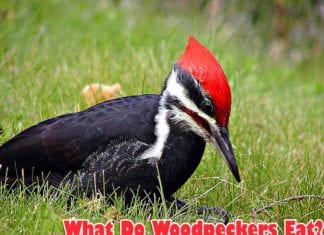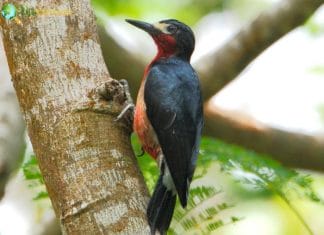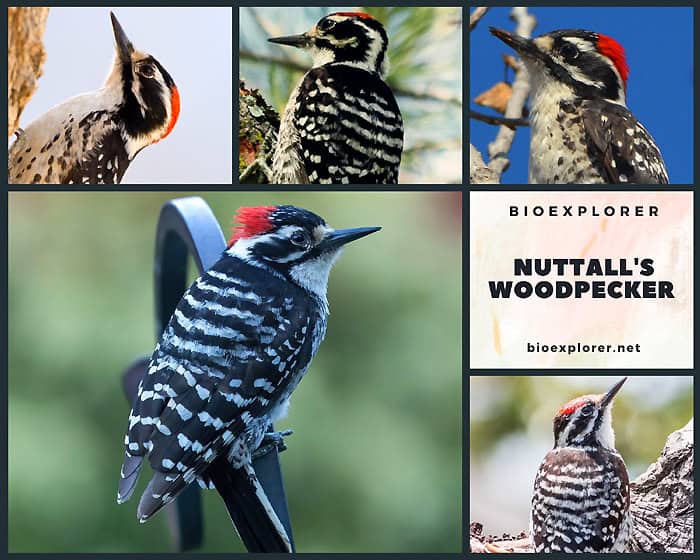
| Animalia | Piciformes | Picidae | Picoides | Picoides nuttallii |
The Nuttall’s woodpecker (Picoides nuttallii) is a small but striking bird native to the western United States, particularly California. This species is a year-round resident in oak woodlands, riparian corridors, and chaparral, making it a familiar sight for birdwatchers across its limited range.
Unlike many migratory woodpeckers, Nuttall’s woodpeckers are non-migratory, remaining in their home territories throughout the year. Their adaptability to both wild and suburban environments has allowed them to persist even as landscapes change.
Table of Contents
- Nuttall’s Woodpecker Characteristics
- Nuttall’s Woodpecker Habitat
- What Do Nuttall’s Woodpeckers Eat?
- What Eats Nuttall’s Woodpeckers?
- Breeding Behavior
- Ecological Importance
- Nuttall’s Woodpecker Fun Facts
- Frequently Asked Questions
- Are Nuttall’s woodpeckers found outside California and Baja California?
- Do Nuttall’s woodpeckers use human-made structures for nesting?
- What elevation range do Nuttall’s woodpeckers inhabit?
- Are Nuttall’s woodpeckers common in suburban areas?
- What is the typical range of egg sizes for Nuttall’s woodpeckers?
- Common Name: Nuttall’s Woodpecker
- Family: Picidae
- Body Dimensions: Around 6-7 inches in length, 13-16 inches in wingspan.
- Male Plumage Colors: Black, white, red crown.
- Female Plumage Colors: Black, white, no red crown.
- Habitat: Oak woodlands; riparian and chaparral environments.
- Diet: Various Insects, larvae, and some fruit.
- Native Countries: USA, Mexico.
- Continent: North America
- IUCN Status: Least Concern.

The Nuttall’s woodpecker was named in honor of Thomas Nuttall, a 19th-century botanist and ornithologist who made significant contributions to the study of North American birds and plants.
Nuttall’s Woodpecker Characteristics
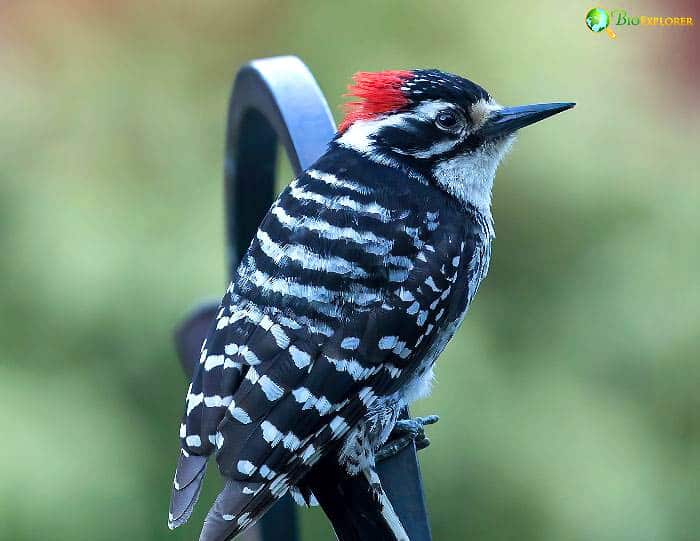
The plumage of the Nuttall’s woodpecker is characterized by a striking black-and-white barred pattern on the back and wings, which provides excellent camouflage against the bark of trees where it forages and nests.
- The underparts are mostly white, with some faint black streaking on the sides and flanks.
- The head features bold black and white markings, including a black crown and nape, white cheeks, and a black stripe extending from the bill through the eye.
- Males are distinguished by a small but prominent red patch on the back of their head, a feature absent in females. Both sexes have sturdy, chisel-like bills, well-suited for drilling into wood to extract insects.
Nuttall’s woodpeckers have short, stiff tail feathers that help them brace against tree trunks while climbing and foraging.
- Their zygodactylWhat is zygodactyl?Zygodactyl describes a foot structure in birds where two toes point forward and two point backward, aiding in climbing and gripping. feet provide a strong grip on vertical surfaces.
- Their wings are relatively short and rounded, adapted for quick, agile flight between trees rather than long-distance travel.
- The overall appearance of the Nuttall’s woodpecker is similar to that of other types of birds, such as the Downy and Ladder-backed woodpeckers. Still, its unique facial pattern and range can help distinguish it.
The species’ small size and bold markings make it both attractive and easily recognizable to bird enthusiasts within its habitat.
Nuttall’s Woodpecker Habitat

The Nuttall’s woodpecker is strongly associated with oak woodlands and riparian forestsWhat is riparian forests?Riparian forests are wooded areas along rivers or streams that help stabilize banks, filter runoff, and provide shelter and food for many animals. throughout its range in California, USA, and northern Baja California, Mexico.
- However, the species’ distribution is limited, mostly confined to the coastal and inland valleys of central and southern California.
- Within these areas, the presence of dead or decaying trees is crucial, as these provide the insects that the woodpeckers feed on and the soft wood needed for excavating nest cavities.
These birds are highly territorial and typically remain within a specific home range throughout the year, rarely venturing far from their preferred habitats.
- In addition to wild landscapes, Nuttall’s woodpeckers have adapted well to suburban and urban areas that retain mature trees, especially oaks and sycamores.
- They are less common in dense coniferous forests or open grasslands, preferring instead the mixed vegetation and structural diversity of their native habitats.
What Do Nuttall’s Woodpeckers Eat?
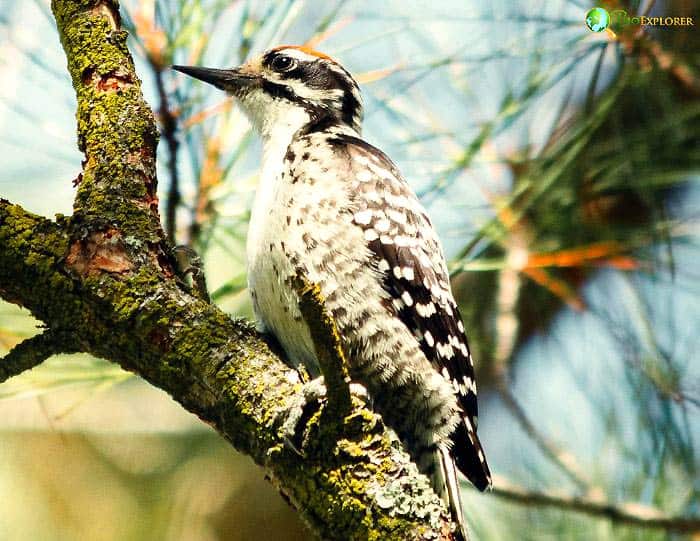
Nuttall’s woodpecker is primarily insectivorous, relying on a diet of ants, beetles, and other small invertebrates found beneath the bark of trees.
- The birds use their strong, chisel-like bills to drill into the bark and wood of trees, exposing hidden insect larvae and adults.
- Ants are a particular favorite, and the woodpeckers will often follow ant trails up and down tree trunks.
In addition to insects, Nuttall’s woodpeckers occasionally consume small amounts of fruit and nuts, especially during seasons when insect availability is low.
- They may also visit backyard feeders for suet, especially in suburban areas where natural food sources are limited.
- However, their diet remains overwhelmingly focused on insects, which provide the necessary protein and energy for their active lifestyle.
Foraging behavior is methodical and persistent. The birds move up and down tree trunks and branches, tapping and probing with their bills to locate prey.
- They also use their long, barbed tongues to extract insects from deep crevicesWhat is crevices?Crevices are narrow cracks or openings, often found in rocks or walls. in the wood.
- This feeding strategy not only sustains the woodpeckers but also helps control insect populations in their habitat, benefiting the broader ecosystem.
Suggested Reading:
What Do Woodpeckers Eat?
What Eats Nuttall’s Woodpeckers?

Nuttall’s woodpecker, despite its small size and agility, faces predation from a variety of animals within its habitat.
- Common predators include larger birds of prey, such as Cooper’s hawks and sharp-shinned hawks, which hunt small birds among the trees and woodland edges where Nuttall’s woodpeckers are active.
- These raptors use surprise attacks and speed to capture woodpeckers either in flight or while they are foraging on tree trunks.
- Other potential predators include snakes, which can climb trees and access nests or roosting sites, as well as mammals, such as raccoons and tree squirrels, which may raid nests for eggs or nestlings.
The woodpecker’s cryptic black-and-white plumage offers some camouflage against tree bark. However, its drumming and foraging activities can still attract the attention of predators. Nuttall’s woodpeckers are also vulnerable at night when they roost in tree cavities.
- Certain types of owls, such as screech owls and great horned owls, are known to prey on small birds and may target woodpeckers during these vulnerable periods.
- The combination of arboreal predators and ground-based threats means that Nuttall’s woodpeckers must remain vigilant to survive in their woodland habitats.
Suggested Reading:
Puerto Rican Woodpecker
Species Name: Melanerpes portoricensisBreeding Behavior
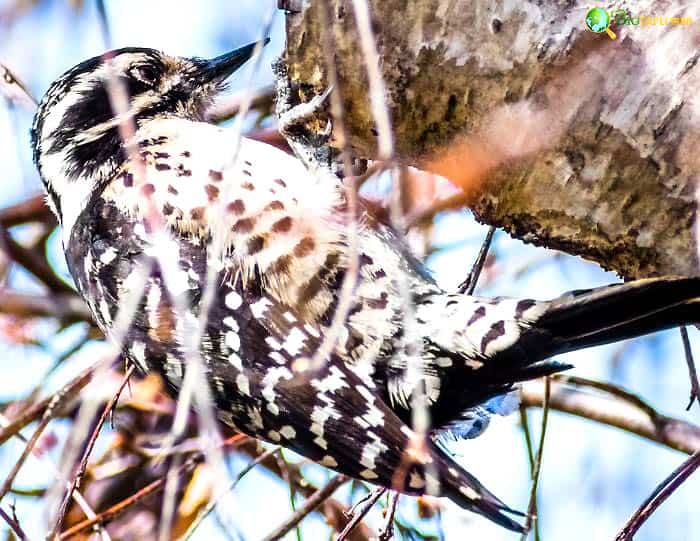
Nuttall’s woodpeckers are monogamousWhat is monogamous?In biology, monogamous refers to a mating system in which an individual has an exclusive reproductive partnership with a single mate during a breeding season or for life. and typically form long-term pair bonds, often returning to the same territory year after year.
- The breeding season typically begins in late winter or early spring, marked by courtship displays that include drumming on trees and vocalizations used to attract mates and establish territory.
- Both males and females participate in these displays, which help strengthen their bond and signal readiness to breed.
Nest site selection is a joint effort, with the pair searching for a suitable dead or decaying tree or large branch in which to excavate a nest cavity.
- The male usually initiates the excavation, but both sexes contribute to the digging process, using their strong bills to create a cavity that is typically 6 to 12 inches deep.
- The entrance hole is just large enough for the adults to enter, helping to protect the nest from larger predators.
Egg laying typically occurs in April or May, during which the female produces a clutch of 3 to 5 white eggs. Both parents share incubation duties, which last around 2 weeks.
- Once the eggs hatch, both adults are highly attentive, feeding the nestlings a diet of regurgitated insects and larvae.
- The young grow rapidly, their eyes opening within a few days, and they are usually ready to fledge in just under a month.
- During the nesting period, the adults are vigilant in defending their territory and nest from intruders, including other woodpeckers and potential predators. The male is often more conspicuous in these defensive behaviors, using vocalizations and physical displays to deter threats.
After fledgingWhat is fledging?Fledging is the stage when a young bird develops enough feathers and strength to leave the nest and begin flying., the young woodpeckers remain dependent on their parents for several weeks, learning essential foraging and survival skills before dispersing to establish their territories. The strong pair bonds and cooperative parenting exhibited by Nuttall’s woodpeckers contribute to their reproductive success and the stability of their populations within their limited range.
Ecological Importance
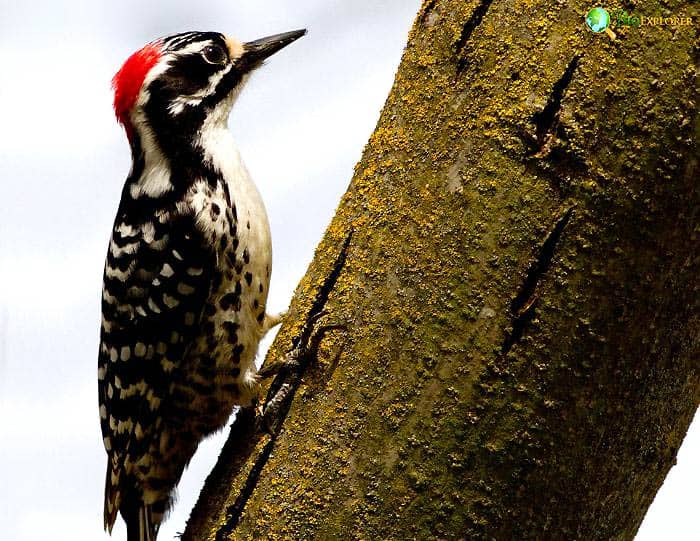
As mentioned previously, Nuttall’s woodpecker is currently classified as a species of Least Concern by the International Union for Conservation of Nature (IUCN), reflecting its relatively stable population and adaptability to various habitats.
- However, as the species is endemic to a limited geographic range, it is vulnerable to habitat loss and fragmentation.
- Urban development, agricultural expansion, and the removal of dead or decaying trees are ongoing threats that could impact local populations.
Despite these challenges, Nuttall’s woodpeckers play a crucial ecological role in their environment.
- By feeding on wood-boring insects and other invertebrates, they help control pest populations, benefiting both natural ecosystems and human-managed landscapes.
- Their abandoned nest cavities provide essential shelter for a variety of other wildlife, including small mammals, songbirds, and even reptiles.
Conservation efforts that preserve mature oak woodlands and riparian corridors are vital for the long-term survival of this species. Encouraging the retention of dead or dying trees in parks, reserves, and even suburban areas can help maintain suitable nesting and foraging sites for Nuttall’s woodpeckers.
Nuttall’s Woodpecker Fun Facts
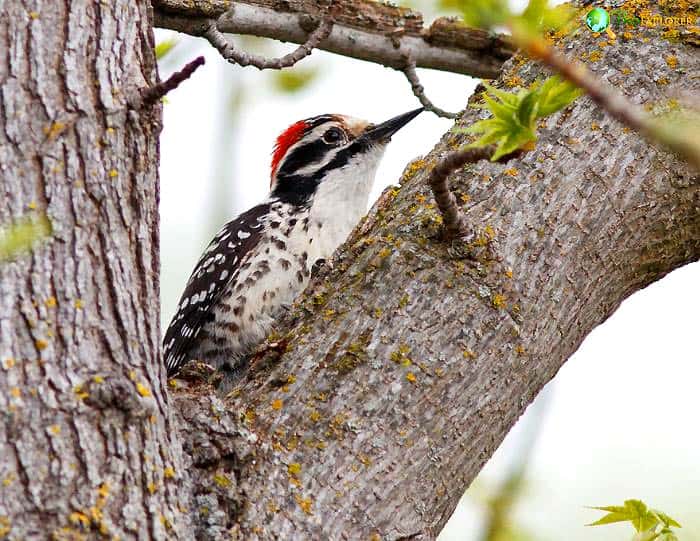
- This species’ drumming is rapid and distinctive, often used to communicate with mates and establish territory boundaries.
- In addition to drumming, they have a sharp, distinctive call used for communication.
- The Nuttall’s woodpecker’s rounded wings and compact bodies allow for quick, agile flights between trees.
- Despite genetic and physical similarities to the ladder-backed woodpecker, hybrids between the two species are very rare.
- Both the male and female parents continue to care for their fledglings for up to two weeks after they leave the nest.
Frequently Asked Questions
Are Nuttall’s woodpeckers found outside California and Baja California?
No, Nuttall’s woodpeckers are endemic to California and northern Baja California, with rare exceptions outside this range.
Do Nuttall’s woodpeckers use human-made structures for nesting?
While they prefer natural tree cavities, they may occasionally use nest boxes if suitable trees are unavailable.
What elevation range do Nuttall’s woodpeckers inhabit?
They are found from sea level up to around 6000 feet but are most common below about 4100 feet.
Are Nuttall’s woodpeckers common in suburban areas?
Yes, they are among the most common woodpecker visitors to backyard feeders in suburban areas with mature trees.
What is the typical range of egg sizes for Nuttall’s woodpeckers?
Nuttall’s woodpecker eggs typically measure about 0.8-1.0 inches in length and 0.6-0.7 inches (1.5–1.7 cm) in width.
The Nuttall’s woodpecker is a resilient bird emblematic of oak woodlands and riparian forests.
The species’ distinctive appearance, non-migratory habits, and important ecological roles make it a favorite among birdwatchers and conservationists alike. Their presence is a reliable indicator of a well-functioning woodland environment. Public awareness and habitat stewardship can help ensure that these woodpeckers continue to thrive for generations to come.
![]()


